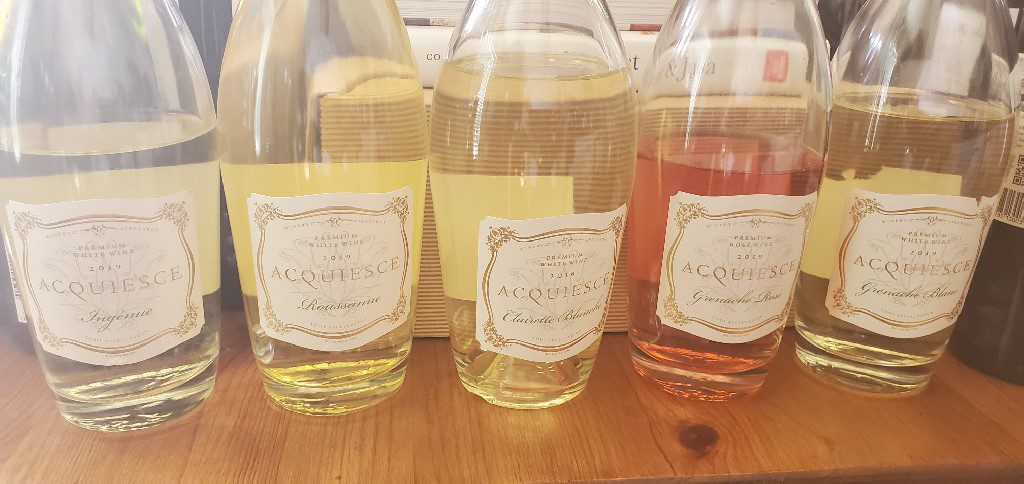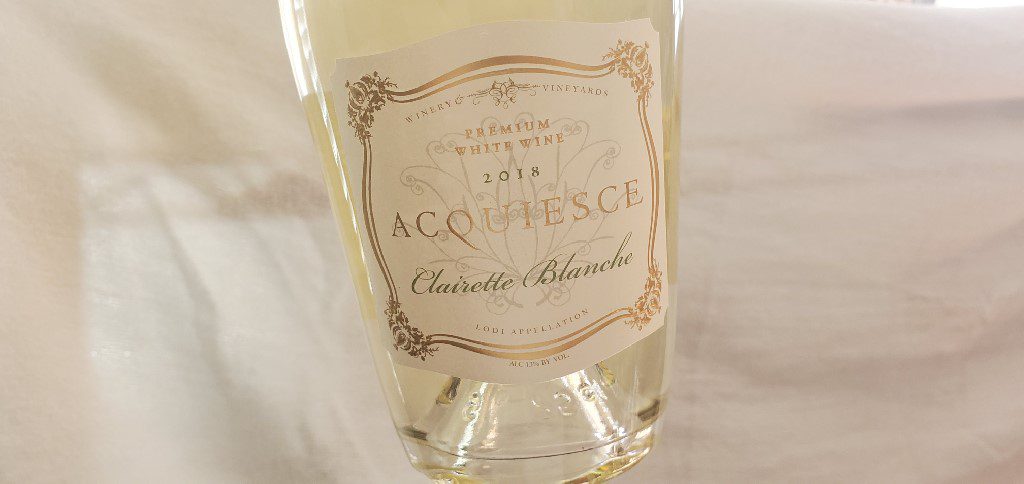
13 Oct White wines from Lodi beckon
I have happily acquiesced to Acquiesce wines! Whether it be due to hot weather outside or to pair with my dinner, the white wines of Acquiesce have become my recent go-to wines. Focusing on white wines, and more particularly on Rhone grape varieties, I wrote about Acquiesce in the Napa Valley Register and share it here.
When temperatures hit an all-time high, all I want to drink is white wine. It does not take much for me to acquiesce to the bright, fresh, crisp flavors of the world of wine wines. There are many regions around the world to find these gorgeous white wines but Lodi, California was not one of the places I expected.
Located in the Central Valley, between the San Francisco Bay and the Sierra Nevada, Lodi is home to more than 100,000 acres of premium wine grapes and more than 80 wineries. Lodi is predominately a red wine grapegrowing region.
It is the self-proclaimed Zinfandel Capital of the World, producing more than 40 percent of California’s premium Zinfandel. And it is home to old vines that survived Prohibition and still produce fruit. Spanish, Portuguese, Italian, German, and Southern Rhone varieties can all be found planted in Lodi, but two-thirds of the plantings are to red grapes.
Lodi has a Mediterranean climate with warm days and cool nights. The Delta Breeze, the local name for the wind that comes off the Delta of the Sacramento River and the San Joaquin River, brings cool air that can reduce the temperature by as much as 40 degrees at night. Lodi has diverse soils that include sandy loam soils, optimal for white grapes.
The climate and soils were not the main focus when Sue and Rodney Tipton moved to Lodi. Originally from Chicago, Sue and Rodney had moved around, even living in Europe. Rodney worked in the corporate world and both of them loved the small-town country feel of Lodi. In 2003, they bought 18 acres in Acampo in the Mokelumne River AVA, which had 12 acres of Zinfandel planted. A wine drinker, foodie and entertainer, Sue found a hobby making rosé from the Zinfandel on her property.
One day, Sue picked up a bottle of white Châteauneuf-du-Pape at her local BevMo. She had never had one, as Châteauneuf-du-Pape Blanc is rather rare. She described it as the best white wine she had ever had but when she returned to BevMo to buy more, she was told that she had purchased the last bottle in California of this private label wine.
This prompted Sue to research more about white Châteauneuf-du-Pape wines. Located in the southern part of the Rhône Valley, the wine appellation is known for its red blends. Châteauneuf-du-Pape can be made with up to 13 different grapes, although unofficially there are 20 different grape varieties. However, only about six percent of the region’s vineyards are white grapes, including Roussanne, Grenache Blanc, Clairette Blanc, Picpoul, Bourboulenc, and Picardan. These white grapes are blended into the red wine and the few Châteauneuf-du-Pape Blanc wines produced are consumed in France or come to the U.S. with a $70 price.
Sue’s research then led her to Tablas Creek in Paso Robles. A pioneer of California’s Rhone movement, Tablas Creek imported several clones of Rhone grapes. In 2008, Sue purchased Grenache Blanc and Grenache Noir from Tablas Creek and planted a half acre of each on her property. It seemed a bit crazy, she explained, to plant something that she had yet to try.
But it was a success and she loved it so much she started pulling out all of the Zinfandel and in 2009 planted Roussanne, Viognier, more Grenache Blanc and 100 vines of Picpoul Blanc. In 2015, Sue added a planting of Clairette Blance and in 2016, she said she was the first to plant Bourboulenc in the United States. All of the grapes Sue planted are from Tablas Creek cuttings from the famous French Château de Beaucastel Winery in the Châteauneuf-du-Pape region.
With seven varieties planted, six of which were white grapes, everyone thought Sue was crazy. There was a perception that you cannot make white wines in Lodi. But Lodi has a history of white wines with Chenin Blanc and Colombard being planted in Lodi before Zinfandel was planted. And today there is a significant amount of Chardonnay planted as well. Sue expressed that “to me, it does not make sense that you can grow a red grape in a hot area but not a white grape.”
In actuality, Sue noted that the temperatures between Lodi and Southern France are almost identical with a two-degree cooler day temperature difference and a two-degree warmer temperature difference at night. By understanding the climate, getting advice from knowledgeable consultants, and tasting the wines of Tablas Creek, Sue was able to create the style of wine that she wanted.
Sue and Rodney Tipton established Acquiesce Winery in 2010 with a release of a few hundred cases. The name was inspired years earlier in the 1990s when they were living in Portland. Rodney had just returned home from ten days of travel to ten countries. They were sitting on their patio drinking wine and listening to k.d. lang’s song “Acquiesce”. Rodney declared to Sue that one day they would have a place in the country called Acquiesce where they would see the sun rise and set. They would have land and love it.
At Acquiesce, Sue has surrendered to the grapes. Her goal is to express the grapes into the glass. The Lodi sustainable certified grapes are hand-picked in the early morning for fresh acidity and hand sorted. The whole clusters are immediately pressed and then cool fermented in stainless steel tanks. No additives are used. All of the wines spend six months on the lees.
Sue started with a few hundred cases of wine. By 2012, she was making 2500 cases and opened the Acquiesce tasting room. Today, from the ten and a half acres of white grapes planted, and one and a half acres of Grenache Noir, Acquiesce produces 4000 cases per year.
It was a Châteauneuf-du-Pape Blanc that first captured Sue’s attention. And today she makes two white blends. Initially, the 100 vines of Picpoul were intended to be in a blend but it was so good alone that it was bottled separately. And the same goes for all of the grapes that are bottled as single varieties.
— Grenache Blanc 2019 ($26)
With three acres of Grenache Blanc planted, this is the Acquiesce signature variety. It has bright fruit aromatics of green apple, pineapple, and pear. On the palate, there is an explosion of flavor that hits the back of the mouth. The wine is vibrant and lively with minerality on the finish.
— Sparkling Grenache Blanc 2018 ($55)
Made in the traditional method, this is a unique sparkling Grenache Blanc. There are only 200 cases produced. It was aged in the bottle for 18 months before disgorgement and is 12 percent alcohol. The wine has lovely floral, citrus and mineral notes with a touch of brioche.
— Bourboulenc 2019 ($28)
The first winery in the U.S. to release this variety, it is an elegant wine with apricot, mango, citrus, mineral notes and fresh bright acidity.
— Clairette Blanche 2019 ($28)
Only 1 acre of Clairette Blanche, a very rare variety, is grown in the Acquiesce estate vineyard. The wine has beautiful aromas of white flowers, apricots, almonds and spicy with a long, fresh finish.
— Ingénue 2019 ($34)
A unique blend of 35 percent Grenache Blanc, 35 percent Clairette Blanc, 20 percent Bourboulenc and 10 percent Picpoul, there were 325 cases made and it sold out in two weeks. Delicate aromas of white flowers, lemon and pear, as well as herbal sage notes, the wine is medium bodied with a lovely balance of acidity.
— Viognier 2019 ($26)
A very fragrant wine with notes of peaches, tangerines and lavender, this pretty Viognier is medium bodied with light, fresh acidity on the back of the palate.
— Roussanne 2019 ($34)
This wine is in harmony and balance with notes of apricot, pear, apple, lemongrass, rose water and Asian spices, roundness on the palate and full mouth acidity.
— Grenache Rosé 2019 ($25)
The only red grape, Grenache Noir, planted at Acquiesce is used for the rosé. A pretty salmon pink color, the wine has a super lush nose of strawberries, cherries and watermelon and gorgeous freshness and minerality on the palate.
Acquiesce is a decade old now. When Sue started, white wine was a token wine. Every winery in Lodi had at last one white wine to add to their line-up. But Acquiesce focused exclusively on white wine and became known for their delicious wines. That is why each year, Acquiesce sells out of their inventory within eight months. Still today, Sue and Rodney do everything by hand. They pay a lot of attention to detail. And they put the finished product in eye-catching custom bottles. The wines of Acquiesce are exceptional and anyone who tries them will easily acquiesce to them.
Read the original story in the Napa Valley Register.
Discover more from Please The Palate
Subscribe to get the latest posts sent to your email.








